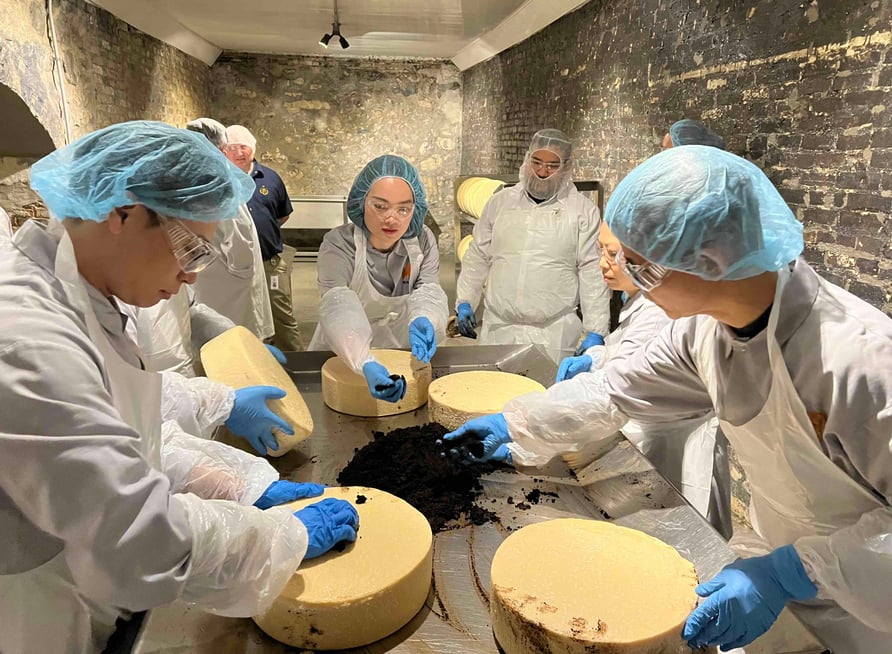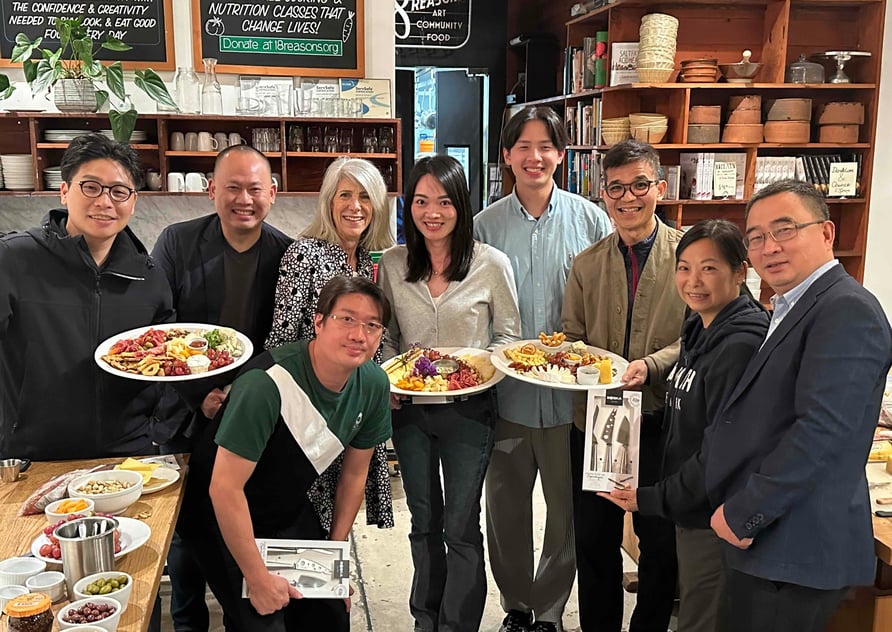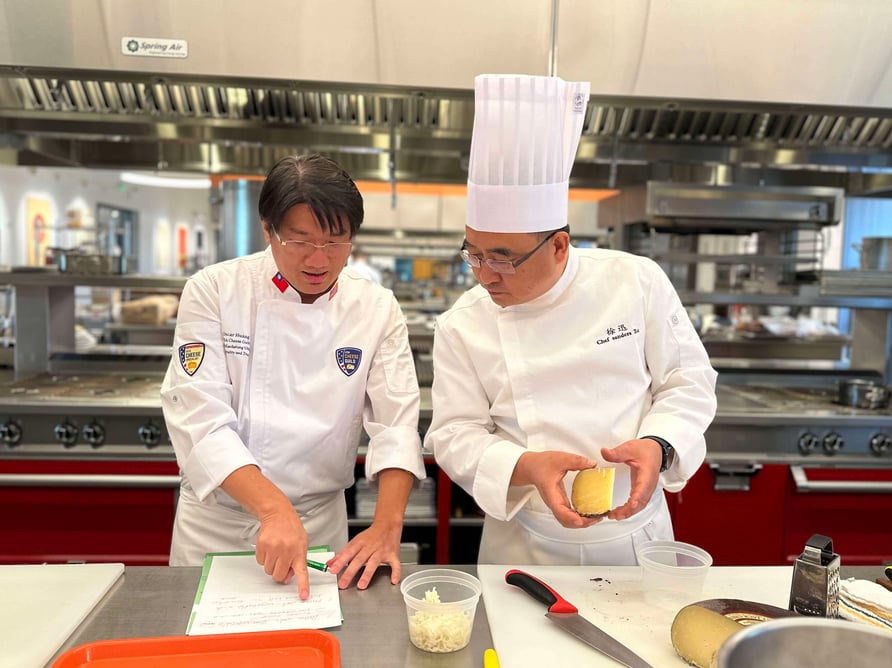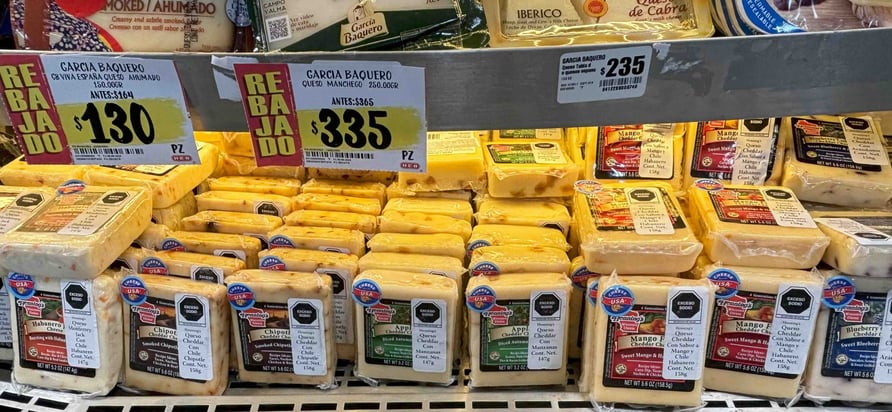HIGHLIGHTS: AUGUST 23, 2024
• Cheese instructors visit U.S. for education mission
• USDEC, Dairy Max and Dallas Cowboys collaborate on cheese promo in Mexico
• China launches probe of EU dairy imports
• Chinese dairy imports lag again in June
• USDEC comments seek more dairy content in food aid products
• Registration open for USDA ag trade mission to Morocco
• Market Summary: GDT surges
• Market Briefs: EU and NZ milk production; bluetongue; Chinese milk prices
• DCANZ urges challenge to Canadian milk pricing system
• Arla inks Sodiaal partnership
• Synlait, a2 settle partnership dispute
• Company news: Starbucks, Emmi, Mars, Nestlé
Featured
USDEC brings cheese instructors to U.S. on education mission
Earlier this month, a group of five instructors from the USA Cheese Guild’s USA Cheese Specialist™ Certification Program visited the United States on a nine-day educational tour aimed at bolstering their U.S. cheese knowledge. The instructors came from China, Hong Kong and Taiwan. They were originally scheduled to participate in the Guild’s 2022 training mission to the U.S. but were unable to attend due to COVID travel restrictions at the time.
These instructors previously received cheese training in their respective countries and have gone on to teach the USA Cheese Specialist Certification Program classes as part of USDEC’s ongoing efforts to increase awareness of and preference for U.S. cheese and build long-term demand. The conference provided them further exposure to and training on the U.S. cheese industry so they can incorporate it into their instruction. It also facilitated the sharing of course implementation insights to further enhance the program offering.
The conference took place Aug. 4-12 in Wisconsin and California. It included hands-on cheese training sessions in both states, visits to dairy farms and cheese manufacturing facilities, as well as retail and foodservice tours.
“USDEC members have told us they recognize the value this training brings and have been receptive to opening their facilities to host our instructors,” said Amy Foor, USDEC vice president, Global Foodservice Programs. “They understand that these instructors are not only front-line trainers but also ambassadors for their companies and products in the overseas markets and can help them to further their export sales.”
Here are a few images from throughout the week-plus event.

Instructors get hands-on cheesemaking experience applying the espresso rub to Sartori Espresso BellaVitano wheels in a Sartori cheese cave in Plymouth, Wisconsin.

The instructors and USDEC and Point Reyes staff at Point Reyes Farmstead Cheese in Point Reyes, California.

Instructors learned about cheese board trends and tried their hand at creating their own cheese boards featuring U.S. cheeses.

Instructors showed off their culinary expertise in the kitchens of the Culinary Institute of America in California, demonstrating their learnings on how U.S. cheese can be incorporated into dishes that can align well with local tastes.
Cheese promo with Dairy MAX, Dallas Cowboys looks to drive retail demand in Mexico
USDEC, in partnership with DairyMAX and the Dallas Cowboys, launched a three-part U.S. cheese promotion in Monterrey City and Saltillo, Mexico earlier this month. The first part of the promotion highlighted U.S. cheeses at twenty HEB stores with four weeks of sampling, signage, banners, and "Cheese from the USA" stickers on U.S. brands at HEB outlets.
For the second part, USDEC, DairyMAX, and the Dallas Cowboys collaborated on in-store interactive promotions in six stores, featuring games, the Cowboys’ mascot Rowdy, and giveaways of Cowboys’ merchandise and “Cheese from the USA” water bottles, cutting boards, and blocks. These promotions began on Aug. 10 and will continue through Sept. 1.
The excitement will continue into October with a U.S. cheese recipe contest. Mexican consumers are encouraged to submit a dish featuring a U.S. cheese to enjoy during football games. The person with the winning recipe will receive an all-expenses-paid trip for two to a Dallas Cowboys game in November. USDEC is partnering with local influencer Angel Soyyo to promote Rowdy’s appearances, games, sampling campaign, and recipe contest.
The initial response to the activities has been strong. We will follow up with performance results in Global Dairy eBrief once all the pieces of the promo have wrapped up.

HEB customers pose with Cowboys’ mascot Rowdy during an Aug. 17 U.S. cheese promotion in Monterrey City. In addition to the photo op, customers also received a spin of the prize wheel.

HEB customer at six stores had the opportunity to sample a variety of U.S. cheeses through most of August. On days when Dallas Cowboys mascot Rowdy visited, the sampling booth stood alongside a merchandise giveaway table and Rowdy’s photo space.

Customers lined up for a chance to test their football passing accuracy—and a chance to collect Dallas Cowboys and “Cheese from the USA” merchandise.

Some of the many U.S. cheeses featuring “Cheese from the USA” labels during the promotion.
China launches probe of EU dairy imports
China has launched an anti-subsidy investigation into dairy exports from the EU. The move is the latest in an ongoing, contentious trade battle that began with EU tariffs on Chinese electric vehicles and has since spread to Chinese investigations of EU pork and alcohol pricing and exports.
According to the Chinese government, the probe will focus on various products intended for human consumption, including fresh cheese and curd, processed cheese, blue cheese, and milk and cream (with a fat content of more than 10% by weight) that is not concentrated.
In a statement on social media, the China Chamber of Commerce said a complaint was lodged against the EU by the Chinese dairy industry on July 29. Consultations were held on Aug. 14. The EU subsequently reduced the electric vehicle tariffs, but China has still decided to move ahead with the dairy investigation.
China will review 20 EU subsidy programs. The investigation is expected to be completed within a year but can be extended for another six months under special circumstances.
The European Commission said it plans to “firmly defend the interests of the EU dairy industry.” Eucolait was critical of the move in light of growing challenges to global food production and supply. “In an era where food security is an ever-pressing priority, it is manifestly unfair that food be sacrificed in an industrial dispute concerning electric vehicles,” Eucolait said.
Some other EU dairy associations and individual governments took a more optimistic tone. The European Dairy Association said it trusted “that the EU and China will find a constructive way to resolve any bilateral disputes, as has happened in the past over other matters.” (Food Ingredients First, 8/23/24; Bloomberg, 8/21/24)
Chinese dairy imports continue to lag but post biggest month since January
Chinese dairy imports (from all sources) posted their 12th straight month of year-over-year (YOY) declines in July, as economic growth and domestic consumption continued to limp along. When the country might return to import growth remains unknown, but there were a few positive signs in the numbers.
Major product import volume has risen for the past two months: +6% from May 2024 to June and +11% from June to July. The July total was 167,904 MT, second only to January’s 178,633 MT. Strong whey and butter demand, a spike in infant formula and improving WMP volume cut the YOY shortfall for the month to only -6%—the first single-digit decline since January.
China’s increased presence at recent Global Dairy Trade auctions (see story below) offers further hope that demand for dairy imports might be trying to mount a comeback.
Whey was one of the few winners in the July import numbers. YOY WPC80+ imports rebounded after a disappointing June, jumping 31% (+782 MT). Low-protein whey imports continue to recover in tandem with the Chinese pig sector. YOY Chinese low-protein whey purchases increased 13% (+6,821 MT) in July, and month-to-month Chinese low-protein whey imports have risen every month since February. July volume—58,678 MT—was the highest of the year.
However, despite the recent rebound, low-protein whey will need to run out the year with similar gains for imports to finish 2024 in the black. Year-to-date (YTD) through July, import volume was still down 9% (-33,912 MT), due primarily to a very rough first quarter.
And despite overall moderating losses in July, China remains mired in a long-term dairy import slump. Through the first seven months of the year, the only products running above year-ago levels were WPC80+ (+5%, +851 MT) and butter (+10%, +5,628 MT). Cheese, which had still been just above record import pace after June, saw YOY July volume slide 10% (-1,690 MT) and is now running -1% YTD (-1,133 MT).
Chinese NFDM/SMP demand hasn’t been this low since 2017. YOY July volume fell 38% (-12,626 MT) and was down 36% YTD (-86,524 MT).
YOY WMP imports fell only 4% (-1,581 MT) but were down 9% YTD (-27,690 MT). YTD volume hasn’t been this low since 2015.
USDEC submits comments to boost milk powder use in food aid products
USDEC and NMPF submitted joint comments to USDA’s Foreign Agricultural Service (FAS) in response to the agency’s Request for Information on non-traditional shelf-stable international food aid commodities to consider in its new $50 million pilot program. USDEC and NMPF strongly support the program as to incorporate a wider group of nutrient-rich products into U.S. food aid programming.
“Dairy powders can play a vital role in delivering a higher nutritional content in U.S. food aid products,” the comments note. To that end, “it’s critical that USDA and USAID [the U.S. Agency for International Development] broaden the products that they procure and distribute as U.S. food aid to include more U.S. dairy products.”
USDEC and NMPF outline two specific examples of how dairy ingredients can be used in the new program to help the more than 225 million children in the world suffering from stunting, wasting or obesity. Those applications are:
- Using milk powder (SMP and NFDM) to produce school milk in controlled settings.
- Adding dairy components to nutritionally fortify blended products, such as using NFDM/SMP or WPC34 in corn/soy blends.
The comments also highlight the benefits of U.S. milk powder and WPC, which include steady supply, affordable cost, product safety, durability and readiness to ship.
USDEC and NMPF urge USDA “to invest in increasing the amount of skim milk powder and nonfat dry milk in school lunch programs around the world, and to bolster its procurement of SMP/NFDM and/or WPC34 to improve the nutritional content of grain-based food aid blends,” the comments conclude.
Events
Registration open for USDA ag trade mission to Morocco
USDA Under Secretary for Trade and Foreign Agricultural Affairs Alexis Taylor will lead a USDA trade mission to Morocco from Dec. 2-4, 2024. Taylor called the mission “a pivotal opportunity for U.S. agribusiness to tap into Morocco’s dynamic market and leverage its strategic position for wider African access.”
Morocco boasts a solid economy and stable government and serves as a key distribution hub for the African continent. Dairy is one of the country’s growing needs. Moroccan dairy imports increased 32% over the last five years. But the U.S. has failed to take advantage of the rising demand.
The trade mission will provide a platform for U.S. suppliers to forge relationships, gather market intelligence and lay the groundwork for new business. It includes B2B meetings with potential importers from Morocco, Senegal, Côte d’Ivoire, and other West African Nations. FAS and trade experts will provide market briefings and organize site visits.
The FAS-sponsored mission aims to connect U.S. agricultural suppliers with prospective customers, giving U.S. companies the opportunity to forge relationships, gather market intelligence and generate sales.
For more details on USDA's Morocco mission, including a registration link, click here.
Market Summary
GDT surges
The Global Dairy Trade (GDT) Price Index surged 5.5% at the Aug. 20 auction, the largest increase in more than 3 years. Prices rose for all products except cheddar. WMP, SMP and AMF posted gains across all contract periods and butterfat rose for all periods except C1.
It was an overwhelmingly bullish result, despite few indications that underlying global market fundamentals had significantly shifted. The big question as usual is China. North Asia (China), which had elevated its presence the previous two auctions, came back full force this time, leading all buyers overall and driving the gains.
China increased purchasing versus the previous auction and previous year for WMP, AMF, butter and cheddar and boosted volume on SMP compared to the previous auction as well (although not the previous year). As noted above, the uptick in Chinese imports in July (compared to June) and its more active stance in recent GDT auctions provide some market optimism for the second half of the year. However, the country’s ongoing economic challenges, depressed consumer purchasing, steady domestic milk production growth, and well-stocked dairy inventories raise plenty of questions about the ultimate strength and durability of its recent buying bump.
Recent optimistic expectations for New Zealand’s milk production season could also moderate price enthusiasm in the weeks ahead.
On the plus side, other regions showed up at the Aug. 20 auction as well. The Middle East increased butter and AMF volumes versus the previous auction and previous year; Southeast Asia purchasing was down compared to the previous auction but still sizable. Africa, South and Central America, and the EU each upped buying in various categories compared to the last auction and the same auction last year.
By the numbers
WMP led the gains, with the average winning price rising 7.2% to US$3,482/MT, its highest prices since October 2022. SMP rose 4.0% to US$2,636/MT, making up some of the ground lost over the previous three auctions.
Butterfat continues to ride high. Butter rose 3.7% to US$6,706/MT and AMF gained 4.8% to US$7,244/MT. It was AMF’s the third straight increase, as it again approaches record levels established in May and June.
Mozzarella gained 5.0% to US$4,810/MT, setting its second record high in a row (in its eight months of trading on the GDT platform). Cheddar was the only outlier. The average winning cheddar price held relatively steady, slipping 0.2% to US$4,274/MT.
Market briefs
A mixture of market news over the past week. Here are some of the recent dairy production and trade developments in world dairy markets.
- Improved pasture conditions helped lift YOY July milk production in New Zealand by 8.4%. (Milk solids output increased 9.2%.) The gain is not as big as it sounds, since June and July only account for a little over 2% of New Zealand’s total seasonal milk output. However, pasture improvements and current market dynamics point to modest growth through the October peak—assuming there are no sudden shifts.
At least one processor, Open Country Dairy, is raising alarm bells about one potential shift: skyrocketing energy costs and the impact they might have on dairy prices in the coming months. New Zealand has failed to account for increased power demands as it has shifted to more sustainable forms of power generation, Open Country says, creating a power supply shortage and causing prices to double over the past 18 months. Current contracts are keeping the problem in check for now, but as those contracts expire, conditions may translate to higher input costs for farmers and higher (i.e., less competitive) product prices for exporters.
- A banner month in France helped lift EU27+UK milk production by 0.9% in June, a bit higher than the 0.6% average the bloc had averaged the previous three months. French output, supported by expected increases due to Olympic demands, jumped 2.9% (significantly higher than its 0.4 and 0.3% gains in April and May, respectively). France owned the highest volume increase in the bloc for the month. Poland and Italy chipped in as well, with gains of 3.8% and 2.9%, respectively. Poland remains on the most consistent growth streak of any country of the EU27+UK: It hasn’t posted a YOY decline in milk deliveries since February 2021.
As noted in last week’s Global Dairy eBrief, farm margins could challenge the EU27+UK’s recent growth streak in the months ahead. In addition, a new threat may be emerging. Several key milk producers are facing a new outbreak of the bluetongue virus. Authorities confirm rising case numbers in Germany, Netherlands and Belgium and new cases in France and Denmark. Spread by insects, bluetongue can do everything from depress milk yields to kill animals (in the most severe cases).
- The long-term decline in Chinese farmgate milk prices is showing up in the corporate results of major milk producers in the country. Modern Farming, AustAsia Group and Shengmu reported profit losses ranging from $18 million-$77 million in the first half due to low milk prices and culled cow prices. Separate data from China’s National Dairy Cow System shows that 80% of dairy farms reported profit losses in May, up from 60% the previous year.
- Algeria’s Office National Interprofessional du Lait et de Produits Laitiers (ONIL), the country’s dairy buying agency, held a new tender for WMP and SMP. The tender reportedly closed Aug. 13, with nearly 50,000 MT of WMP and 25,000 MT of SMP sold. Press reports suggest the bulk of the WMP came out of New Zealand, Argentina and Uruguay, and the SMP originated from Europe.
- The Kuwait government is rolling out subsidies to encourage domestic milk production. While officials did not release the size of the budget, they plan to fund farmers who possess licenses to raise cows, provided those farmers meet technical and health conditions and supply raw milk to licensed Kuwaiti dairy companies. Separately, the government is also setting aside money to supplement the cost of feed for livestock breeders. (USDEC Middle East/North Africa office; USDEC China office; Farmers Weekly, 8/19/24; Shropshire Star, 8/19/24; Agence France Presse, 8/13/24)
Trade Policy
DCANZ urges NZ government to file challenge to Canadian dairy export subsidy
Dairy Companies Association of New Zealand (DCANZ) is urging the government to challenge Canada’s Class 4(a) milk pricing system at the WTO. DCANZ alleges the system functions as an illegal milk production subsidy that is driving a Canadian milk surplus that is spilling over into international markets as SMP and, more recently, milk protein concentrates and isolates. DCANZ said that unless action is taken, there is “immediate risk” to NZ$500 million (about US$306 million) in New Zealand MPC exports and, longer term, eventual risk to NZ$400 million (about US$245 million) in casein exports.
The dairy industry group contacted New Zealand Trade Minister Todd McClay to advance the case. McClay said he would meet with the industry to discuss the matter. The dairy sector needs to build the case by demonstrating harm and quantifying the impact of Canada’s pricing system before any challenge could be leveled, he said.
TRQ challenge
McClay also said that the New Zealand government is looking to take additional actions to challenge Canada’s tariff rate quota (TRQ) allocation system at the Comprehensive and Progressive Agreement for Trans-Pacific Partnership (CPTPP). In a situation reminiscent of the U.S. challenge to Canada’s TRQ system under the U.S.-Mexico-Canada Agreement, New Zealand said Canada has failed to comply with a CPTPP dispute settlement ruling last year that the system violated its CPTPP trade obligations. Canada implemented a modified TRQ system in May that New Zealand says fails to comply with that ruling.
Company News
Arla announces plans to grow ingredients business, partnership with Sodiaal
Denmark-based Arla Foods Ingredients (AFI) said the company will discontinue its Early Life Nutrition (ELN) B2B business at its ARINCO site in Videbæk, Denmark, and turn that facility into a dedicated ingredients production site. Currently, the ARINCO site produces dairy ingredients and milk powder for AFI’s B2B ELN sales and Arla’s branded ELN business. The changeover will take place over the next 19 months.
Arla plans to maintain and expand its branded ELN business in large part through a new partnership with French cooperative and ELN producer Sodiaal. Under the terms of the partnership, Arla and Sodiaal will collaborate to accelerate their China ELN businesses and Sodiaal will produce all of Arla’s future needs for ELN products in China as well as other Arla markets. (Company reports)
Synlait, a2 settle partnership dispute
Synlait Milk and The a2 Milk Co. conditionally agreed to resolve all disputes related to their contract manufacturing agreement that were currently in arbitration (see Global Dairy eBrief, 9/22/23 and 1/5/24). Synlait agreed to forgo its exclusivity arrangement to produce certain a2 brands effective Jan. 1, 2025, although the company expects it will continue to produce those products for at least the short term.
Synlait will also continue to hold Chinese State Administration for Market Regulation (SAMR) registration attached to its Dunsandel, New Zealand, manufacturing plant for one of a2’s Chinse labeled products marketed in China and will keep producing that product unless and until a2 obtains its own Chinese SAMR registration. Synlait also agreed to make available to a2 an additional SAMR registration slot at Dunsandel for a potential new China label product.
In addition, as part of the settlement, a2 will make a one-time payment to Synlait of NZ$24.75 million (about US$15 million).
The settlement is conditional on Synlait completing an equity raise and a refinancing of its existing banking facilities (see Global Dairy eBrief, 7/19/24). (Company reports)
Starbucks looking for growth in India
In an effort to double its store count in India, the U.S. coffee chain Starbucks will experiment with store formats and beverage offerings throughout the country, including a suite of non-coffee beverages including milkshakes and Masala chai. The company, which runs its Indian stores under a joint venture with local conglomerate Tata Group, said it is looking to open more smaller outlets and coffee stands in outlying areas, as well as adding more non-coffee beverages and foods tailored specifically to the Indian palate. Starbucks currently operates 441 stores in India and aims to increase that number to 1,000 by 2028. (Bloomberg, 8/13/24)
Emmi releases half year 2024 results
Emmi Group revenues dropped 4.1% in the first half of 2024 compared to the same period of the previous year. The company attributed the decline to the sale of its Gläserne Molkerei dairy operation and negative currency effects as a result of the devaluation of the Chilean peso, the euro and the U.S. dollar against the Swiss franc. But the company also noted its recent acquisition of Verde Campo in Brazil has had a “slightly positive effect” on sales. The report noted “encouraging” results in strategic niches, including premium desserts in Italy and cheese exports from Switzerland in the specialty cheese sector—specifically the Kaltbach premium cheese specialties, which displayed strong growth in Germany and the Netherlands. Looking ahead, Emmi says it expects sales growth to be slightly higher in the second half of the year. (Company reports)
Mergers, acquisitions and joint ventures
As part of efforts to grow its snacking business, Virginia-based Mars agreed to buy Chicago-based Kellanova (formerly known as the Kellogg Co.) for nearly $36 billion. The deal is expected to close in the first half of next year. (Company reports)
Company briefs
Nestlé CEO Mark Schneider is stepping down after eight years of leading the food and dairy multinational. The Nestlé board appointed Laurent Freixe, currently executive vice president and CEO Zone Latin America (LATAM), to replace him effective Sept. 1. (Company reports)
In Case You Missed It...
U.S. Dairy Exporter Blog
Market analysis, research and news subscribe hereUSDEC Twitter feed
Follow us here.